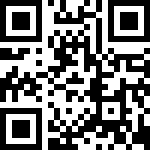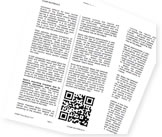About QR-Codes
An informational article about QR-Codes which are commonly called mobile barcodes.
Glossary

Picture of QR-Code
Definition
QR-Codes are two dimensional barcode (datamatrix) that is designed to have its contents decoded at a high speed.
About the Name
The acronym QR is derived from the term Quick Response. The company Denso Wave originally spawned the term 'QR' as the creator intended that such barcodes and their contents were to be decoded at high speed electronically.
History
QR-Codes originated within the technology hungry country of Japan, and have only recently began to become popular within the Middle East and Europe.
Barcodes that you see on any commercial product are extremely beneficial as their reading speed, supreme accuracy and their functionality are key.
As barcodes reached their peak and began getting used worldwide, the need for more data and character types to be stored was inevitable.
Developers began tying to expand on the current amount of bars within the barcode and how their positioning resides to allow further data capacities. The need for smaller barcodes also was another defining factor in QR-Codes development.
Such developments failed as reading and printing implications caused more problems than solutions. The 2D barcode was then born.
Overview
QR-Codes first hit mainstream when they were initially used for tracking parts by vehicle manufacturers. After a while, companies began to see a newscope for where QR-Codes could be used elsewhere within the world. The most commercial use for QR-Codes is in the telecommunications industry where the mobile phone seems to be the biggest driver of their popularity.
Mobile Phones
With the technology of mobile phones constantly expanding, especially within mobile internet, QR-Codes seemed the perfect solution to quickly and efficiently bring mobile phone users onto the mobile web. QR-Codes can be used to store all kinds of data including URLs (Universal Resource Locator) or as most people know them; web addresses. This then allowed offline publications such as:
- Magazines
- Papers
- Business Cards
- Buses
- Signs
- T-shirts
Or basically any medium that can accept the print of a QR-Code to advertise their online product which would then direct the user to there preferred channel i.e. website.
How They Work?
Take a mobile phone such as the iPhone; nearly ever mobile phone has a digital camera in todays world. The camera, along with decoding software can be used to capture a picture of the QR-Code, of which the QR-Code software decoder can then transform the data held with the QR-Code to a meaningful action for the mobile phone:
- Connect to a web address
- Download a MP3
- Dial a telephone number
- Prompt your email client with a sender address
This can all be done within a matter of milliseconds making the transformation from a users mobile phone to the mobile web instantaneous.
Standards
The Japanese standard for QR-Codes, devised by Denso Wave, is JIS X 0510, which was released in January of 1999. The corresponding ISO International Standard, ISO/IEC 18004, was then approved in June of 2000. The standard was then updated back in 2006. (ISO/IEC 18004:2006).
Data Capacity
QR-Codes are capable of handling of sorts of data, including numbers, alphabetic characters, Kanji, Kana, Hiragana, symbols, binary and control codes.
A total of 7,089 characters can be encoded in one symbol alone.
| Numeric only | Max 7,089 characters |
| Alphanumeric | Max 4,296 characters |
| Binary (8 bits) | Max 2,953 bytes |
| Kanji, full-width Kana | Max 1,817 characters |
Barcodes vs. QR-Codes

Picture of Traditional Barcode
QR-Codes have become more popular than the typical barcode as the typical barcode can only hold a maximum of 20 digits, whereas the QR-Code can hold up to 7,089 characters. This makes the use and diversity of QR-Codes much more appealing than their older counter part, the barcode.
Partially part of the reason QR-Codes can hold more data, is because if you compare a typical barcode to a QR-Code, you can see one major difference; barcodes only span horizontally whereas QR-Codes can span both horizontally and vertically.
Statistic – QR-Codes are capable of encoding the same amount of data in approximately one-tenth the space of a traditional barcode. Such minute QR-Codes are called Micro QR-Codes.
Position
A great feature of QR-Codes is that you do not need to scan them from one particular angle. QR-Codes are capable of omnidirectional (360 degree’s) high-speed reading. QR-Codes scanners are capable of determining the correct way to decode the content within the QR-Code due to the three specific squares that are positioned in the corners of the symbol.

Multiples
QR-Codes can be combined into one large symbol. One symbol can then be divided into 16 separate symbols making the data capacity extremely large.
References
Useful Links
Below we have compiled a list of useful links that we have found on the web that may be worth visiting regarding QR-Codes:
- Wikipedia - quality wiki about QR-Codes.
- Denso Wave - everything there is to know about QR-Codes.
- MC2 - the Mobile Codes consortium.
For a full list of QR-Code related websites, see our useful links page. Got a useful website our readers would benefit from visiting? Please send it to us and tell us why you think it should be added to our website.



